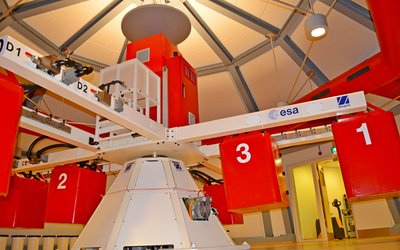Meet the teams: BubCoa
Four teams of university students were selected to develop and perform their hypergravity experiments during ESA's 'Spin your Thesis!' 2011 campaign. Here is an introduction to the Spanish team.
![]()
![]()
Collision of an air bubble with a free surface at different gravity levels
![]()
![]()
| University | Universitat Politècnica de Catalunya (UPC) |
| Endorsing professor |
Ricard González Cinca Applied Physics Department, UPC |
| Team | Anna García, Oscar Maldonado, Francesc Suñol, Eduardo Vidal Arco |

The main objective of the experiment was to investigate the effects of the gravity level on the processes which cause rising, bouncing and coalescence of bubbles upon impact with a free surface.
When a bubble rises in a liquid, the drag force counteracts its buoyancy, resulting in a constant rise terminal velocity. If the bubble approaches the free surface with a velocity higher than a certain critical value, it bounces a few times before the coalescence occurs. At every bounce, a certain amount of energy is lost in the interaction with the free surface, and the approach velocity of the bubble decreases until a critical value at which coalescence occurs. In contrast, if a bubble is small enough to have a terminal velocity lower than a certain threshold, the bubble coalesces with the free surface as soon as it touches the interface, and no bouncing takes place[1].

To date, all of the studies concerning the bubble bouncing process have been carried out in normal gravity. The effects of viscosity and surface tension have been investigated, but this was the first time that such an experiment had been conducted at different gravity levels. This is important because the gravity level is one of the key parameters that governs the bouncing dynamics.
The results obtained from this experiment helped to improve the understanding of bubble processes in liquids and two-phase flows at different gravity levels. Specifically, the critical rise velocity value, the transition from a straight to a helical path, and the frequency of the bouncing process were investigated.
Read the final experiment report here.






